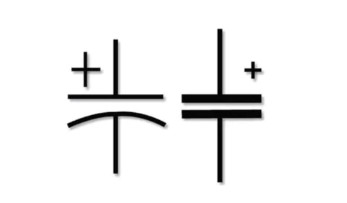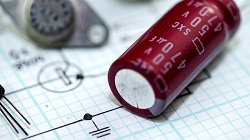
What is Capacitor, Types, Uses, and Working?
In this article, we are going to discuss what is capacitor, working and its types. Capacitors are electronic devices that store electrical energy. Electrical energy stored in the capacitor is in the form of electrical charge. The effect of a capacitor is called capacitance. Capacitors are primarily used in electronic circuits for example printed circuit boards. The work of the capacitor in the electronic circuit blocks the direct current period alternating current to pass. The unit of the capacitor is the Farad. [F].

This is a capacitor symbol.
The more uses of capacitors like this. Capacitors are used to maintain the voltage at a certain level. Capacitors are used for reducing voltage pulsation. The capacitor is a passive electronic device with two terminals. Capacitors have high tolerance and accuracy and are more stable with changes in voltages and temperature. This is the best thing for the capacitor. Many types of capacitors are in electronics and electrical systems. For example, we use a number of capacitors in the printer circuit board. The capacitor is a passive electronic component. The capacitor stores energy in the form of an electrostatic field. Capacitors are mostly used in an electronic circuits.

Types of Capacitors
Capacitors are mainly divided into two mechanical groups.
- Fixed Capacitors
- Variable Capacitors
Fixed Capacitors
Fixed capacitors are those whose capacitance is fixed. These types of capacitors do not change. These capacitor stores a fixed amount of charge. The fixed capacitor provides a fixed amount of capacitance.
This is a fixed capacitor. For example, fixed capacitors like paper capacitors, plastic capacitors, and mica capacitors. This capacitor is helpful for maintaining a constant charge and energy output. The capacitance of a fixed capacitor is fixed and does not change. It is called the fixed capacitor.
Variable Capacitor
This type of capacitor is a capacitor whose capacitance may be intentionally and repeatedly changed. The main purpose of a variable capacitor is a varying the electric charge. In this case, the charge is not fixed. Some use a variable capacitor like this. The variable capacitor is used in resonant circuits, such as radios and tuners. The variable capacitor is also used in prototyping an electronic circuit design. It is called variable capacitors.
This is a symbol of the variable capacitor. Fixed capacitors and variable capacitors are the main types of capacitors but some other types of capacitors. Now, I explaining other capacitors.
Ceramic capacitors, film capacitors, power film capacitors, electrolytic capacitors, and paper capacitors
Capacitors Types Explained
Ceramic capacitors
The ceramic capacitor is a fixed-value capacitor. The ceramic capacitor is a multilayer capacitor. The ceramic capacitor has two or more alternating layers. A metal layer act as the electrodes. Ceramic capacitors are of special shapes and styles. Ceramic capacitors are split into two applications.
- Ceramic capacitors offer high stability and low losses.
- These capacitors offer the high volumetric efficiency for buffers.
Paper Capacitors
A Paper capacitor is also called a fixed capacitor. The paper capacitor stores the amount of electric charge. Paper is used as the dielectric material. Larger capacitors are used for energy storage and small capacitors are used in electronic devices. Capacitors are manufactured in many styles and forms. The capacitors are mostly used to store the high electric current in the electronics circuit. For example, capacitors are used in printed circuit boards. The main function of a capacitor in a printed circuit board is to temporarily hold an electric charge, and release an electric charge when more power is needed.
Electrolytic Capacitor
An electrolytic capacitor is also known as a polarized capacitor. In this capacitor, the anode plate is made of metal. There are three families of electrolytic capacitors like aluminum electrolytic capacitors, niobium electrolytic capacitors, and tantalum electrolytic capacitors. An electrolytic capacitor is mostly used for decoupling or noise filtering in power supplies. These capacitors are polarized components because of their asymmetrical. The failure of electrolytic capacitors can be hazardous.
A bipolar electrolytic capacitor can also be made by connecting two normal electrolytic capacitors in series, anode to anode and cathode to cathode. Capacitors, together with resistors and inductors, belong to the group of passive components in electronic equipment. Larger capacitors are used for energy storage in such applications as strobe lights.
We are using different types of capacitors for different purposes. The oxide layer is also used in electrolytic capacitors. The act of this oxide layer is the dielectric of the capacitor. Electrolytic capacitors have much higher capacitance-voltage. Different types are used depending on required capacitance, working voltage, current handing capacity, and other properties. Standard capacitors have a fixed value of capacitance, but ductile capacitors are frequently used in tuned circuits. There are electrolytic capacitors.
Film Capacitors
Film capacitors are also known as plastic film capacitors, film dielectric capacitors, and polymer film capacitors. The dielectric films depend on the desired dielectric strength. There are used in many ac and dc microelectronics and electronics circuits. Film capacitors are electrical capacitors. These types of capacitors work in the electrical components. The electrodes of film capacitors may be metalized aluminum or zinc applied directly to the surface of the plastic film. Film capacitors are very similar to those used for ordinary film capacitors.
Uses of Capacitors
Energy storage, pulsed power and weapons, power conditioning, power factor correction, suppression and coupling, motor starters, and sensing.
Capacitors have many uses in the electrical and electronic systems. They are so ubiquitous that it is rare an electrical product does not include at least one for some purpose.
Properties of Capacitors
The very prime property of a capacitor is capacitance. The capacitance set out the capability of a capacitor to store electrical energy for the given value of voltage. When capacitors are connected in parallel, the full capacitance is the sum of the individual capacitors’ capacitance. When capacitors are connected in series, the full capacitance is less than any one of the series capacitors’ individual capacitance.
Advantages and Disadvantages of capacitor
Capacitors can charge and accumulate energy quickly. The capacitor can provide stored energy quickly. These are the advantages of capacitors, now I will discuss the disadvantages of capacitors.
Losses are small compared to other storage mediums. Capacitors have a long service life and low maintenance.
What is Capacitor Formula?
The capacitor Formula is given by the equation C = εA/d, In this equation, A is the parallel plate area C is capacitance; ε is permittivity, a term for how well dielectric material stores an electric field; and d is the distance between the two conductive plates.
What is Capacitor?
Capacitors are electronic devices that store electrical energy. Electrical energy stored in the capacitor is in the form of electrical charge. The effect of a capacitor is called capacitance.
Also Read about What is Transformer?

